Outcrop-Scale Hydraulic Fracturing Experiments with a Coagulable Resin and Data Analysis Results
Abstract
:1. Introduction
2. Materials and Methods
2.1. Location and Geology
2.2. Fracturing Fluid and Equipment for the Experiments
2.2.1. Coagulable Resin
2.2.2. Double Packer
2.3. Method of the Experiment
2.3.1. Borehole Allocation and Workflow of the Experiment
2.3.2. AE Measuring Method
3. Results
3.1. Evaluation of Local Rock Stress
3.2. Resin Fracturing Test and Overcoring
- A large hole (250 mm diameter) was drilled from the ground floor to a depth of 1 m.
- A resin fracturing hole (76 mm diameter) was drilled at the bottom of the 250 mm central hole to a depth of 9 m.
- Resin fracturing tests were conducted at depths of 2.1 and 3.3 m.
- After the resin fracturing test, a 205 mm diameter core was recovered by drilling coaxially around the RF1 or overcoring.
3.3. Distribution of AE Hypocenters
3.4. Analysis of Failure Mechanisms
4. Discussion
5. Conclusions
Author Contributions
Funding
Data Availability Statement
Conflicts of Interest
References
- Li, Q.; Li, Y.; Cheng, Y.; Li, Q.; Wang, F.; Wei, J.; Liu, Y.; Zhang, C.; Song, B.; Yan, C.; et al. Numerical simulation of fracture reorientation during hydraulic fracturing in perforated horizontal well in shale reservoirs. Energy Sources Part A Recovery Util. Environ. Eff. 2018, 40, 1807–1813. [Google Scholar] [CrossRef]
- Cipolla, C.L.; Warpinski, N.R.; Mayerhofer, M.J. Hydraulic Fracture Complexity: Diagnosis, Remediation, and Exploitation. In Proceedings of the SPE Asia Pacific Oil & Gas Conference and Exhibition, Perth, Australia, 20–22 October 2008; p. SPE-115771-MS. [Google Scholar]
- Maxwell, S.C.; Urbancic, T.I.; Steinsberger, N.; Zinno, R. Microseismic Imaging of Hydraulic Fracture Complexity in the Barnett Shale. In Proceedings of the SPE Annual Technical Conference and Exhibition, San Antonio, TX, USA, 29 September–2 October 2002; p. SPE-77440-MS. [Google Scholar]
- Mayerhofer, M.J.; Lolon, E.P.; Warpinski, N.R.; Cipolla, C.L.; Walser, D.; Rightmire, C.M. What is Stimulated Reservoir Volume (SRV)? In Proceedings of the SPE Shale Gas Production Conference, Fort Worth, TX, USA, 16–18 November 2008; p. SPE-119890-MS. [Google Scholar]
- Hubbert, M.K.; Willis, D.G. Mechanics of hydraulic fracturing. Pet. Trans. AIME 1957, 210, 153–168. [Google Scholar] [CrossRef]
- Talebi, S.; Cornet, F.H. Analysis of the microseismicity induced by a fluid injection in a granitic rock mass. Geophys. Res. Lett. 1987, 14, 227–230. [Google Scholar] [CrossRef]
- Maxwell, S.C.; Cipolla, C.L. What does microseismicity tell us about hydraulic fracturing? In Proceedings of the SPE Annual Technical Conference and Exhibition, Denver, CO, USA, 30 October–2 November 2011; p. SPE-146932-MS. [Google Scholar]
- Haimson, B.; Fairhurst, C. Hydraulic fracturing in porous-permeable materials. J. Pet. Technol. 1969, 21, 811–817. [Google Scholar] [CrossRef]
- Cheung, L.S.; Haimson, B.C. Laboratory study of hydraulic fracturing pressure data—How valid is their conventional interpretation? Int. J. Rock Mech. Min. Sci. Geomech. Abstr. 1989, 26, 595–604. [Google Scholar] [CrossRef]
- Guo, F.; Morgenstern, N.R.; Scott, J.D. An experimental investigation into hydraulic fracture propagation—Part 1. Experimental facilities. Int. J. Rock Mech. Min. Sci. Geomech. Abstr. 1993, 30, 177–188. [Google Scholar] [CrossRef]
- Guo, F.; Morgenstern, N.R.; Scott, J.D. An experimental investigation into hydraulic fracture propagation—Part 2. Single well tests. Int. J. Rock Mech. Min. Sci. Geomech. Abstr. 1993, 30, 189–202. [Google Scholar] [CrossRef]
- Guo, F.; Morgenstern, N.R.; Scott, J.D. An experimental study of well communication by hydraulic fracturing. Int. J. Rock Mech. Min. Sci. Geomech. Abstr. 1993, 30, 203–218. [Google Scholar] [CrossRef]
- Morita, N.; Black, A.D.; Fuh, G.F. Borehole breakdown pressure with drilling fluids—1. Empirical results. Int. J. Rock Mech. Min. Sci. Geomech. Abstr. 1996, 33, 39–51. [Google Scholar] [CrossRef]
- Bunger, A.P.; Detournay, E. Experimental validation of the tip asymptotics for a fluid-driven fracture. J. Mech. Phys. Solids 2008, 56, 3101–3115. [Google Scholar] [CrossRef]
- Chen, Y.; Naoi, M.; Akai, T.; Tanaka, H.; Takagi, S.; Ishida, T. Method for Visualizing Fractures Induced by Laboratory-Based Hydraulic Fracturing and Its Application to Shale Samples. Energies 2018, 11, 1976. [Google Scholar] [CrossRef]
- Naoi, M.; Chen, Y.; Yamamoto, K.; Morishige, Y.; Imakita, K.; Energies Tsutumi, N.; Kawakata, H.; Ishida, T.; Tanaka, H.; Arima, Y.; et al. Tensile-dominant fractures observed hydraulic fracturing laboratory experiment using eagle ford shale. Geophys. J. Int. 2020, 222, 769–780. [Google Scholar] [CrossRef]
- Naoi, M.; Chen, Y.; Nishihara, K.; Yamamoto, K.; Yano, S.; Watanabe, S.; Morishige, Y.; Kawakata, H.; Akai, T.; Kurosawa, I.; et al. Monitoring hydraulically-induced fractures in the laboratory using acoustic emissions and the fluorescent method. Int. J. Rock Mech. Min. Sci. 2018, 104, 53–63. [Google Scholar] [CrossRef]
- Ishida, T.; Fujito, W.; Yamashita, H.; Naoi, M.; Fuji, H.; Suzuki, K.; Matsui, H. Crack Expansion and Fracturing Mode of Hydraulic Refracturing from Acoustic Emission Monitoring in a Small-Scale Field Experiment. Rock Mech. Rock Eng. 2019, 52, 543–553. [Google Scholar] [CrossRef]
- Ishida, T.; Desaki, S.; Kishimoto, Y.; Naoi, M.; Fujii, H. Acoustic emission monitoring of hydraulic fracturing using carbon dioxide in a small-scale field experiment. Int. J. Rock Mech. Min. Sci. 2021, 141, 104712. [Google Scholar] [CrossRef]
- JGS3761-2017; Method for Initial Stress Measurement by Hydraulic Fracturing Technique. Japanese Geotechnical Society Standard: Osaka, Japan, 2020.
- Takanami, T.; Kitagawa, G. A new efficient procedure for the estimation of onset times of seismic waves. J. Phys. Earth 1988, 36, 267–290. [Google Scholar] [CrossRef]
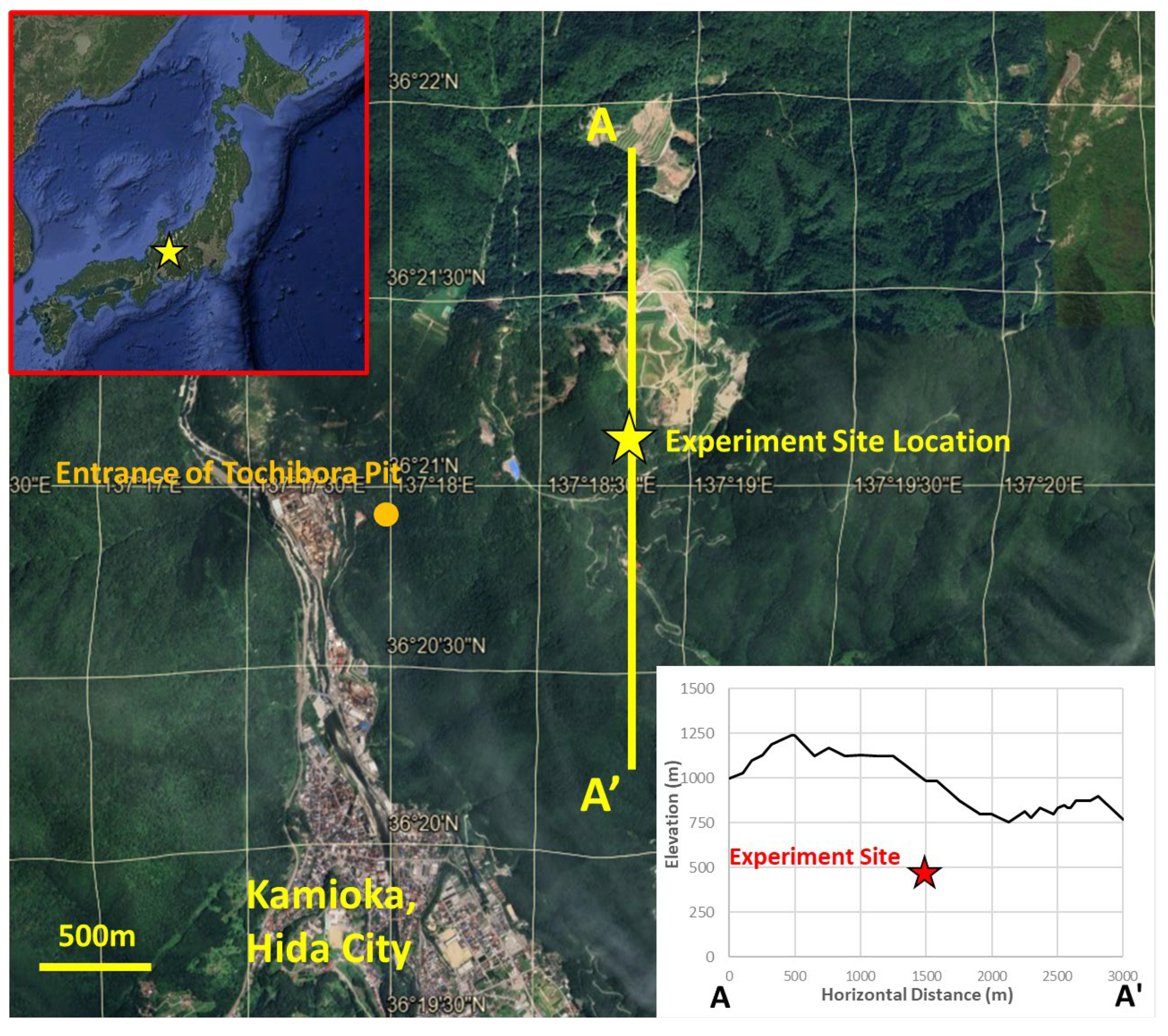
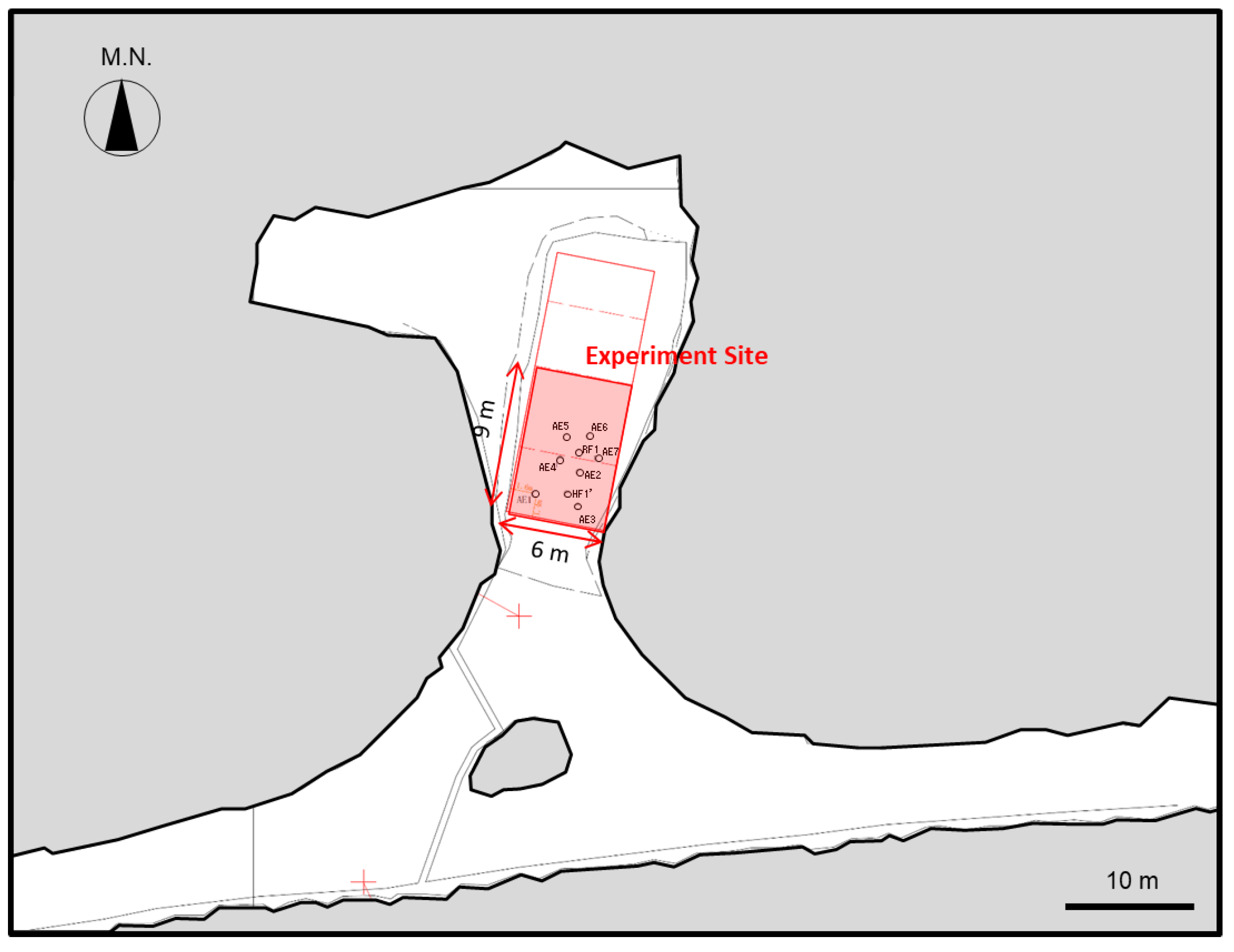

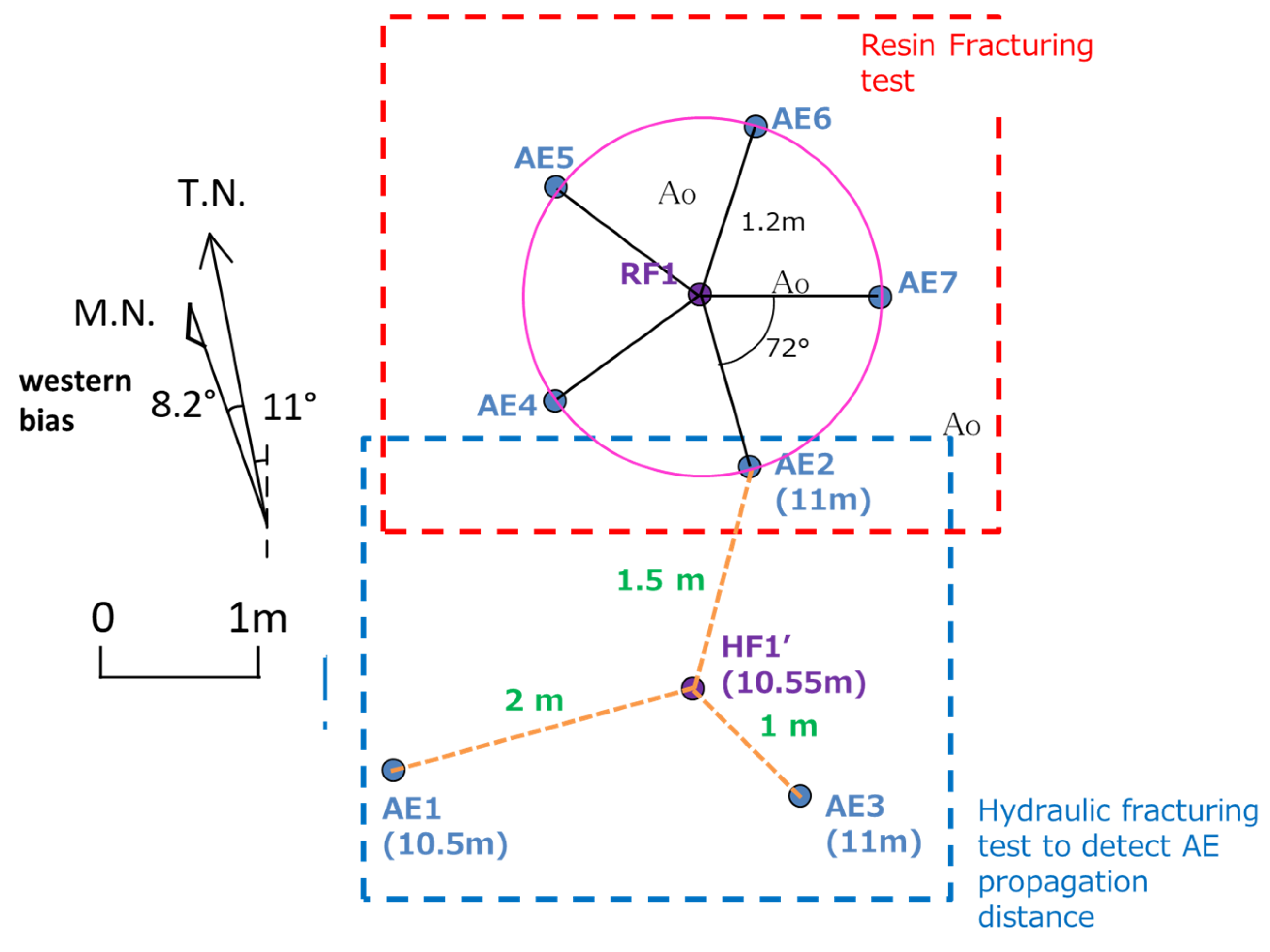

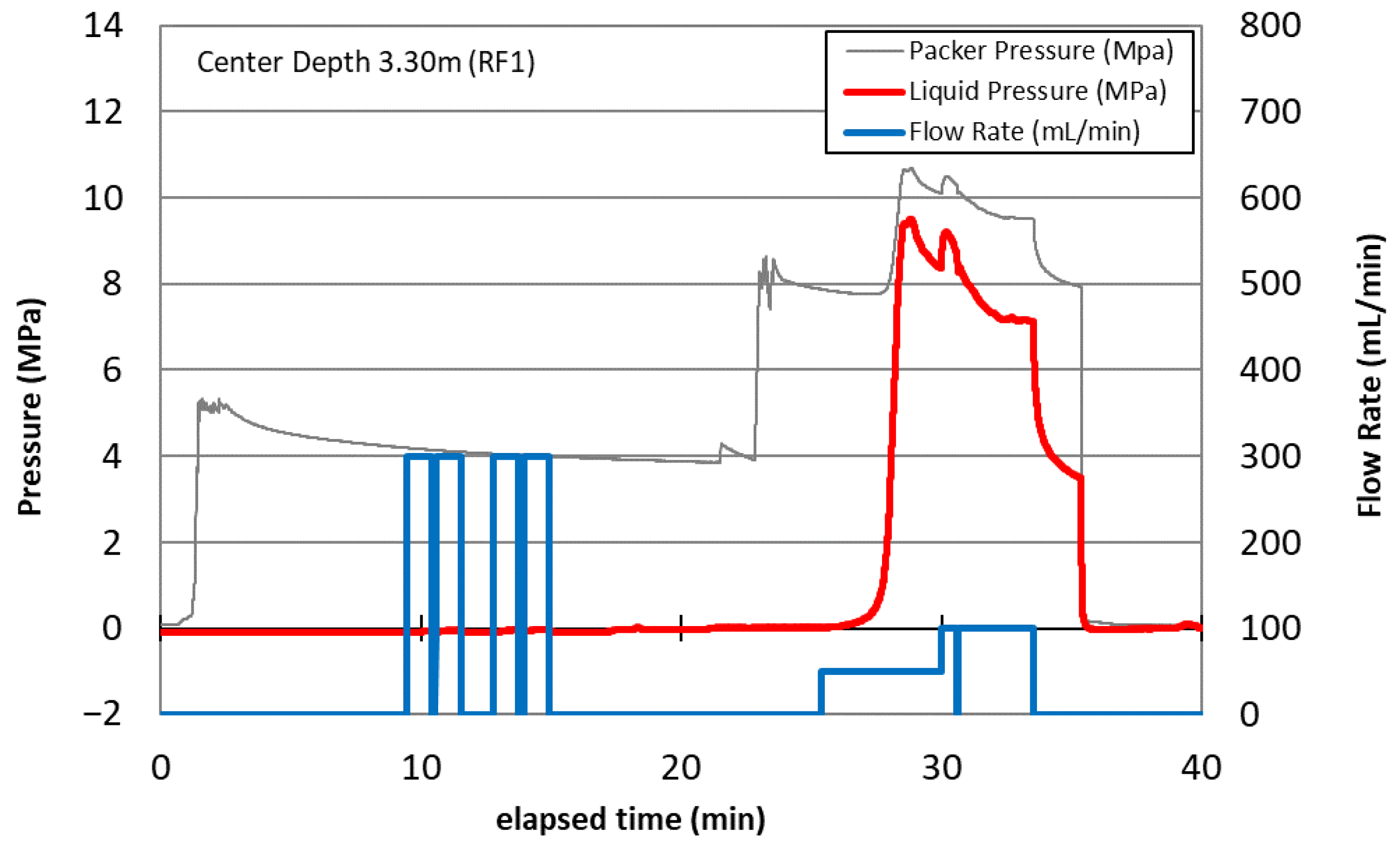
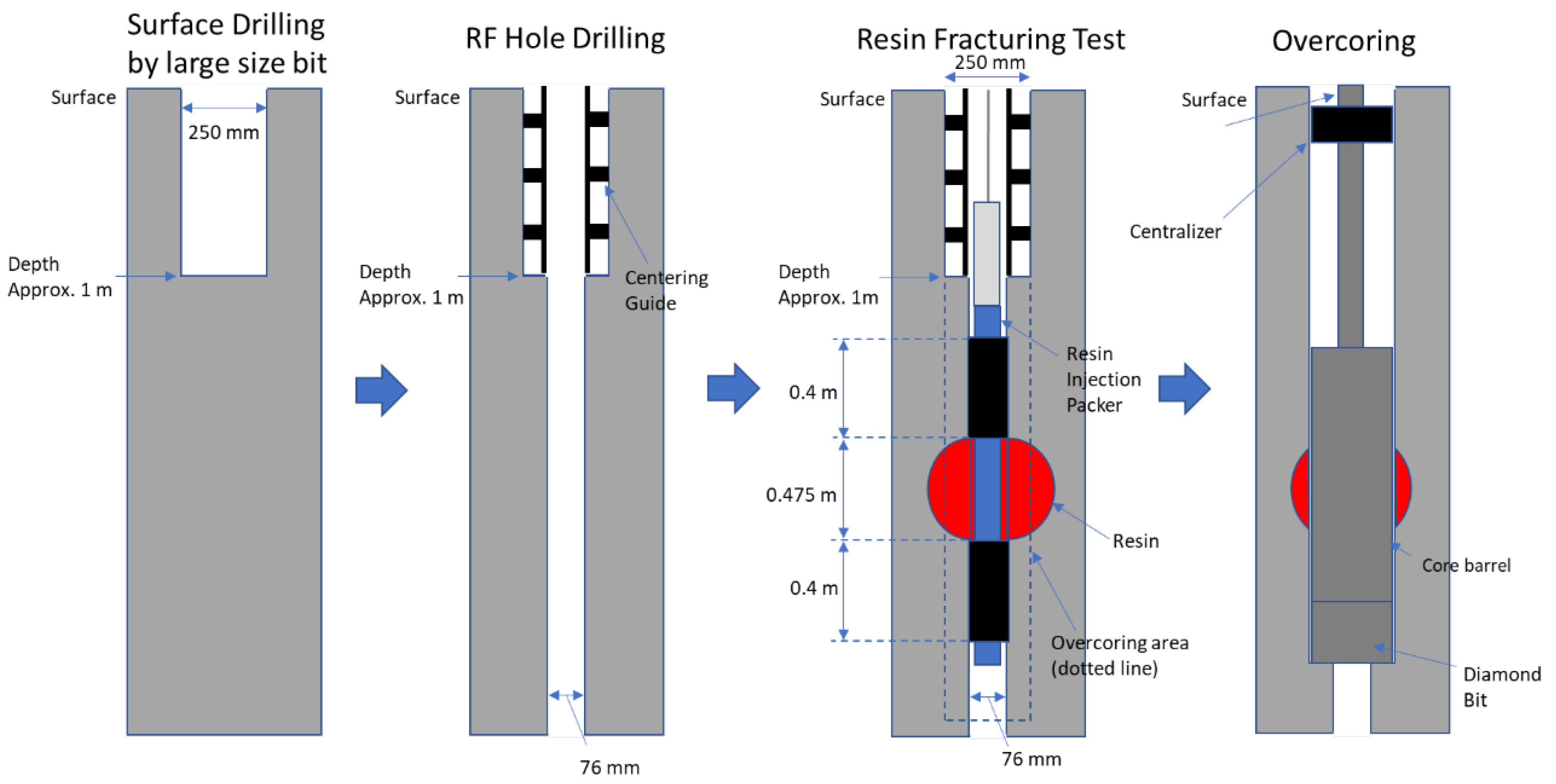
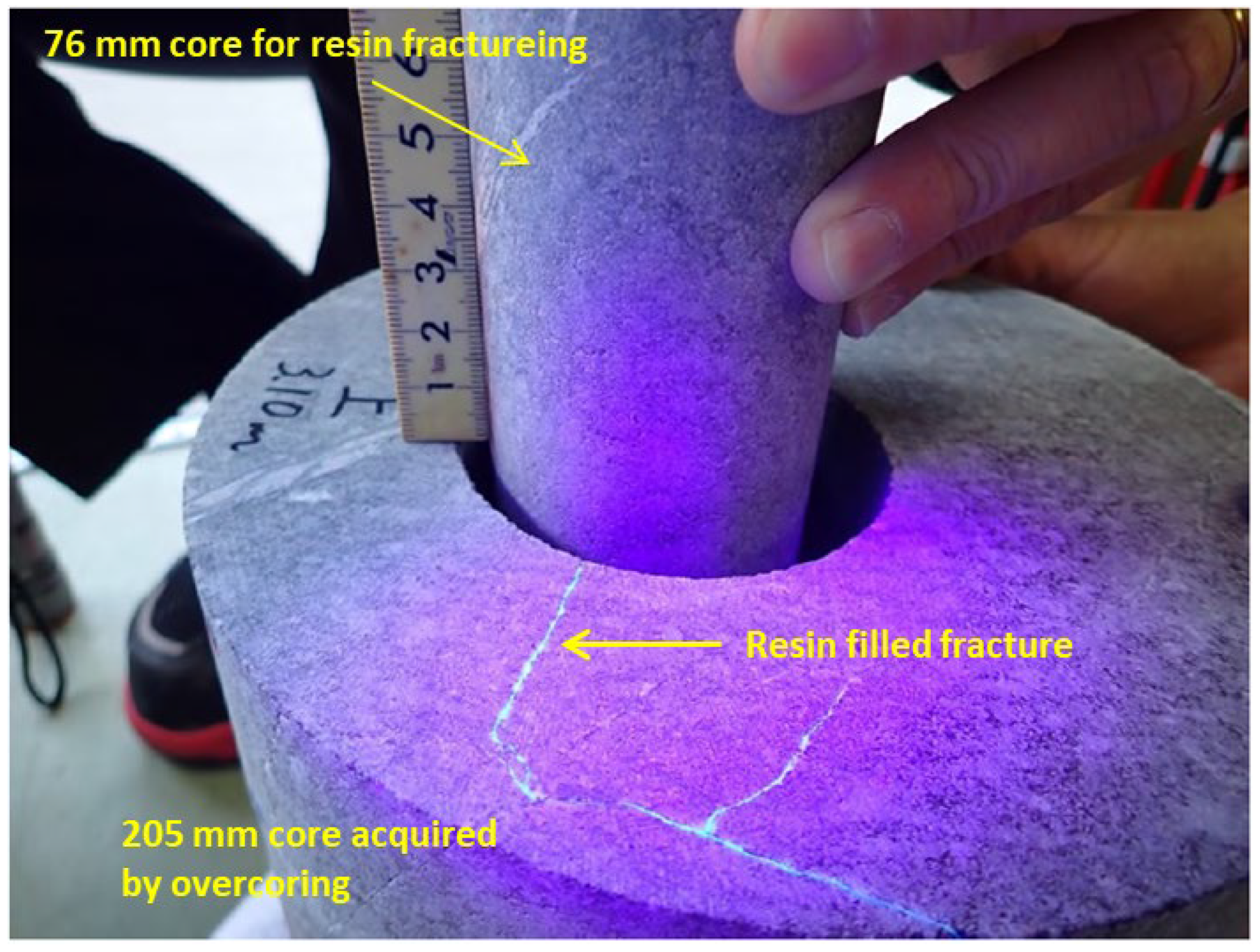
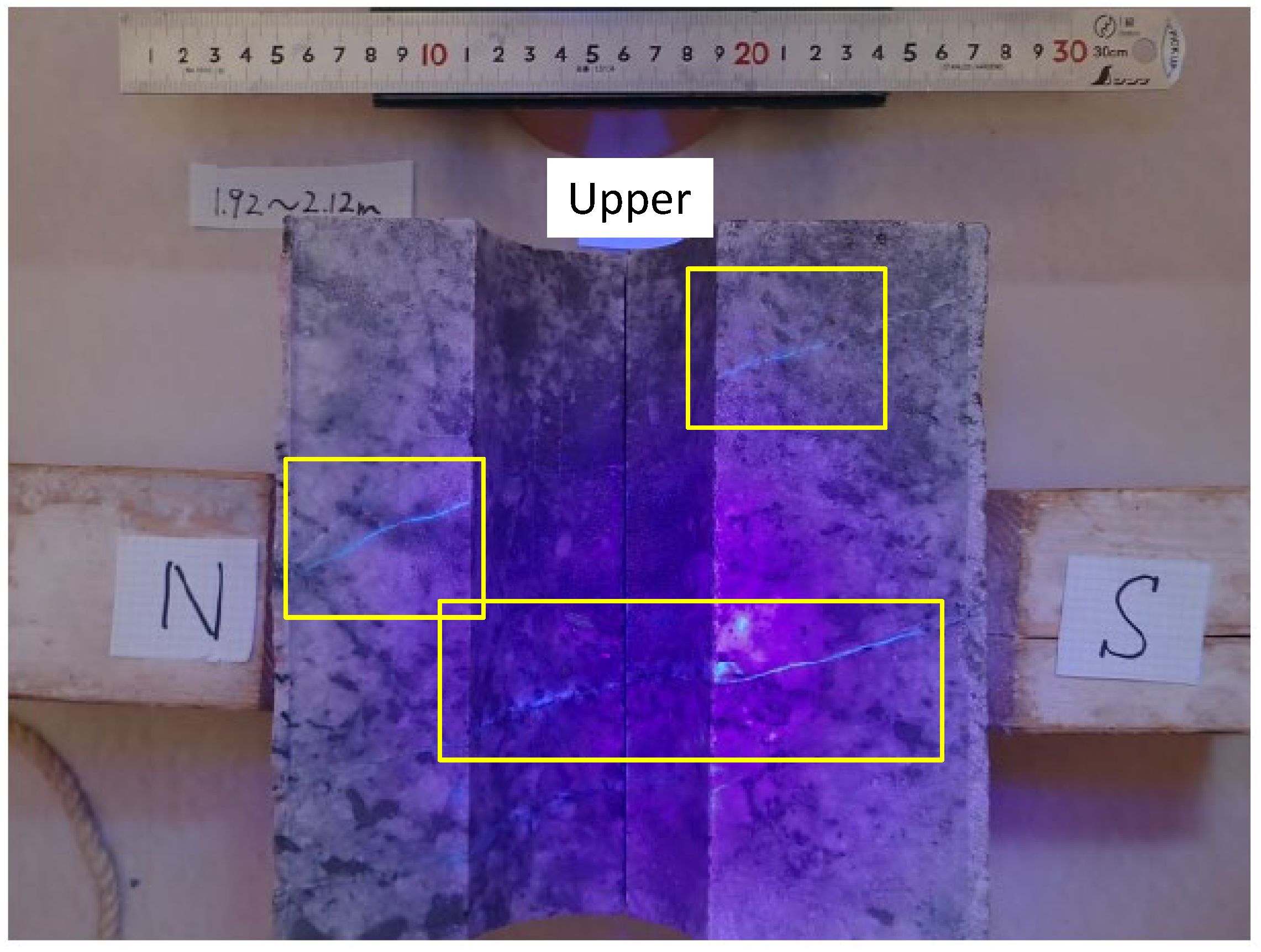
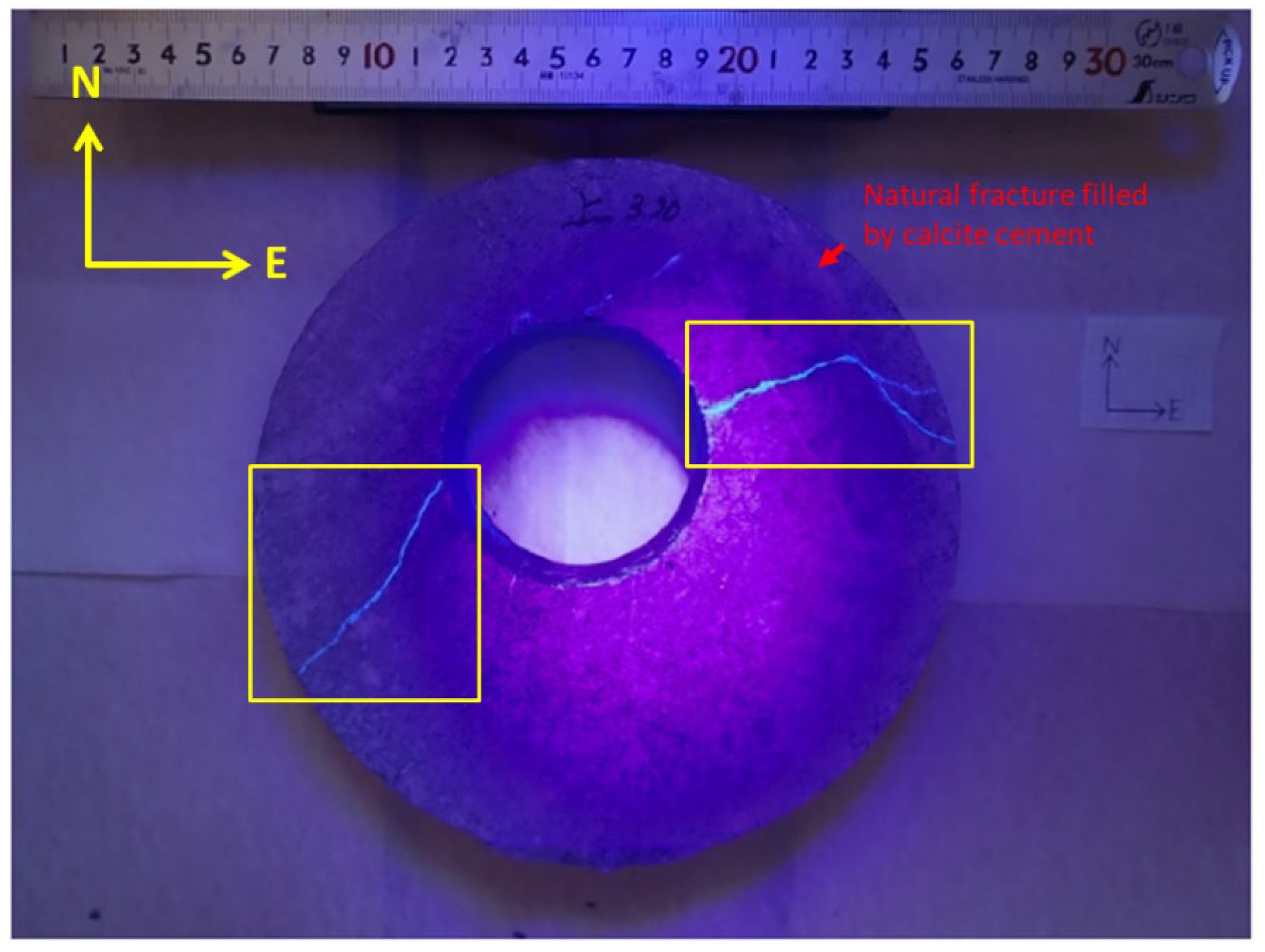

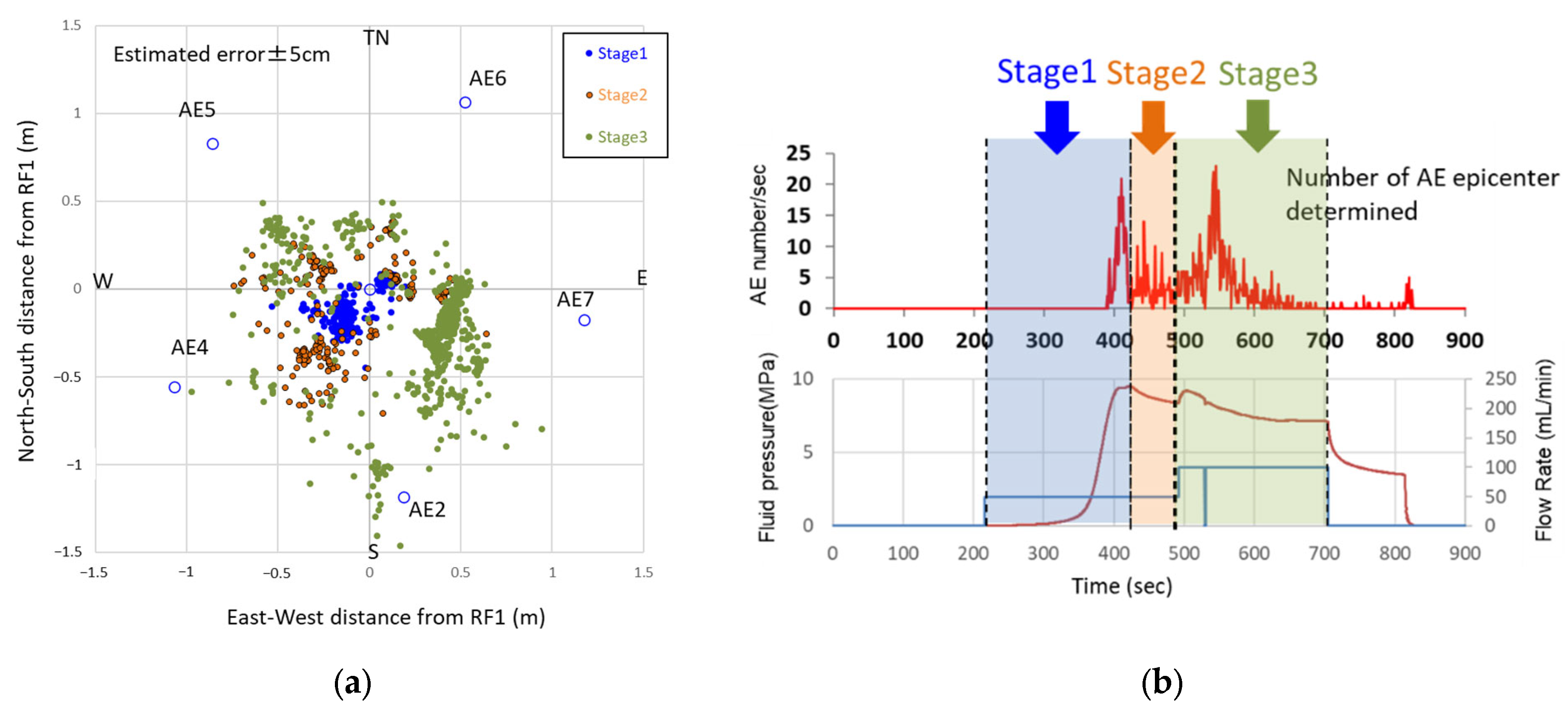
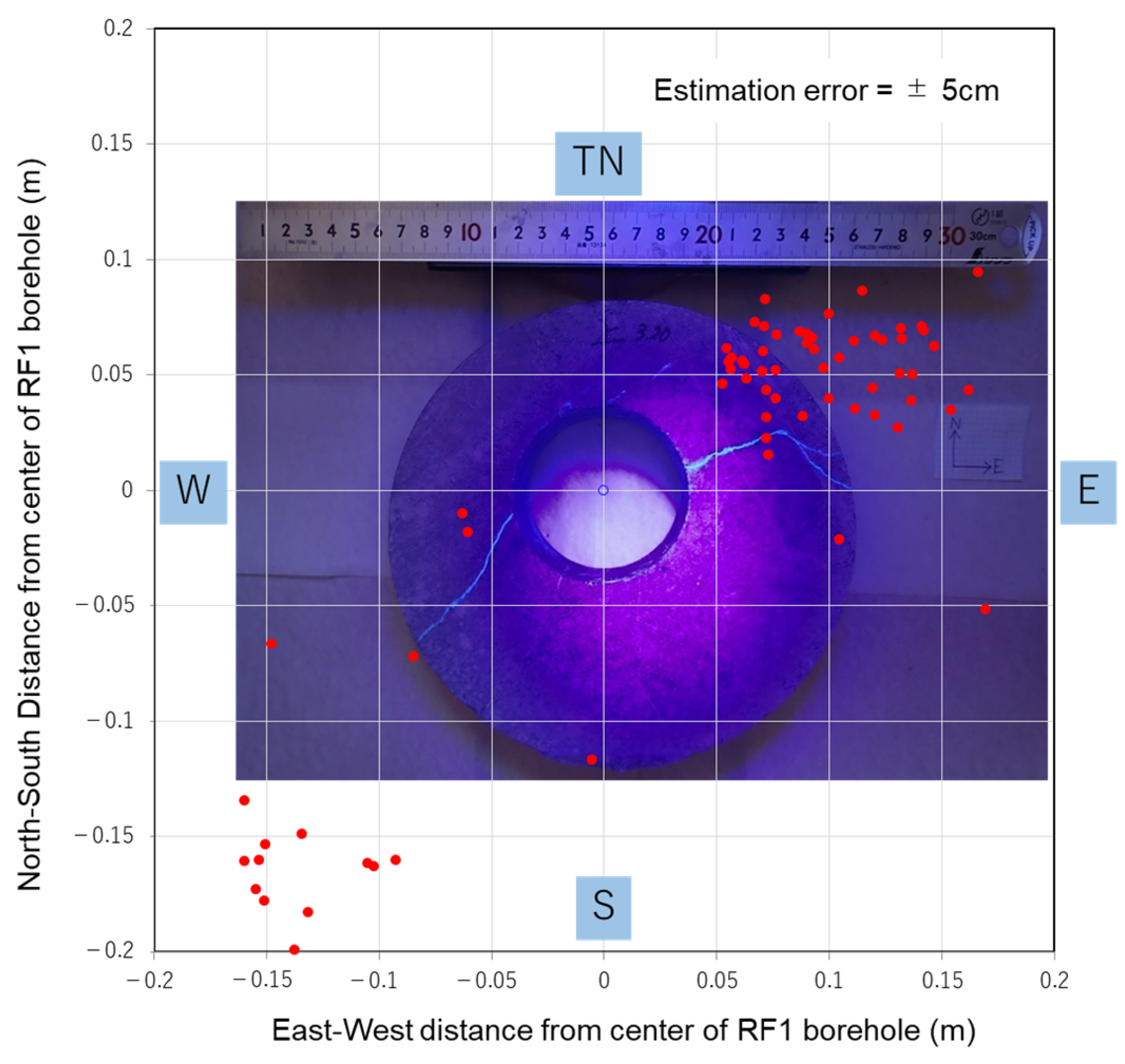
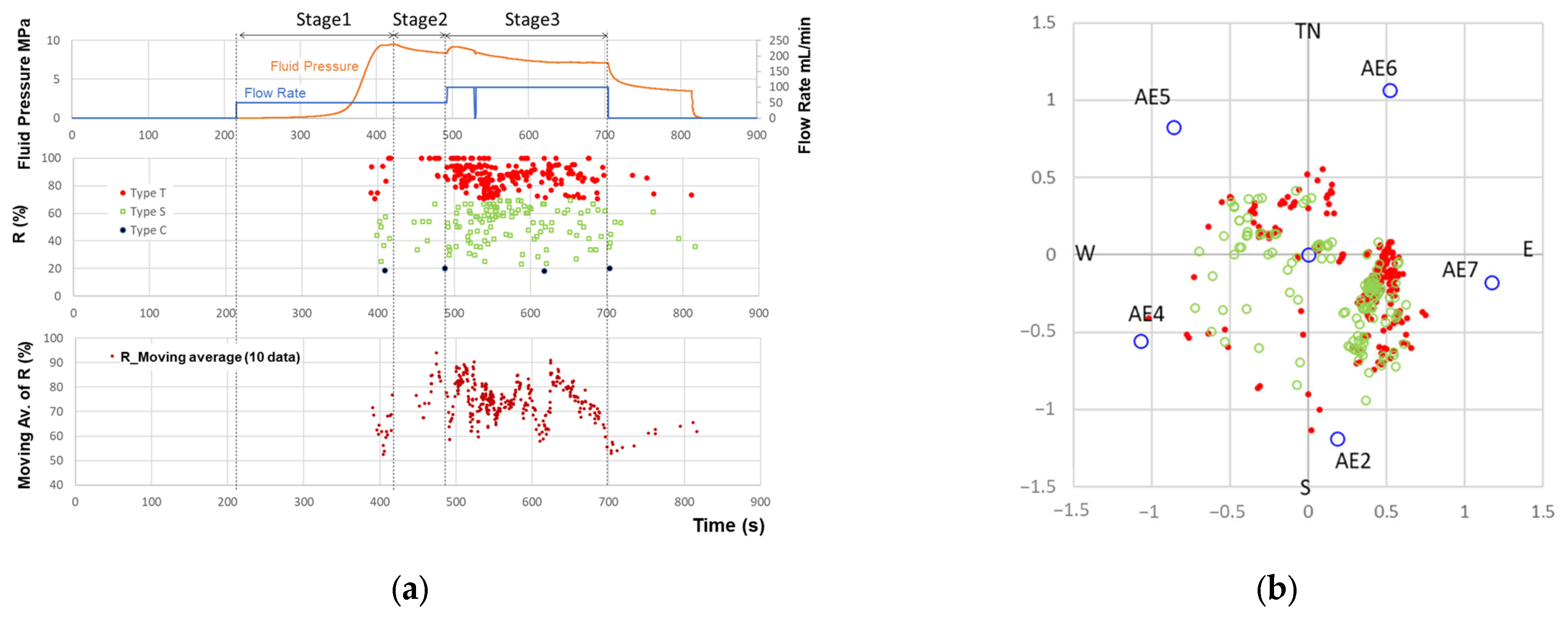


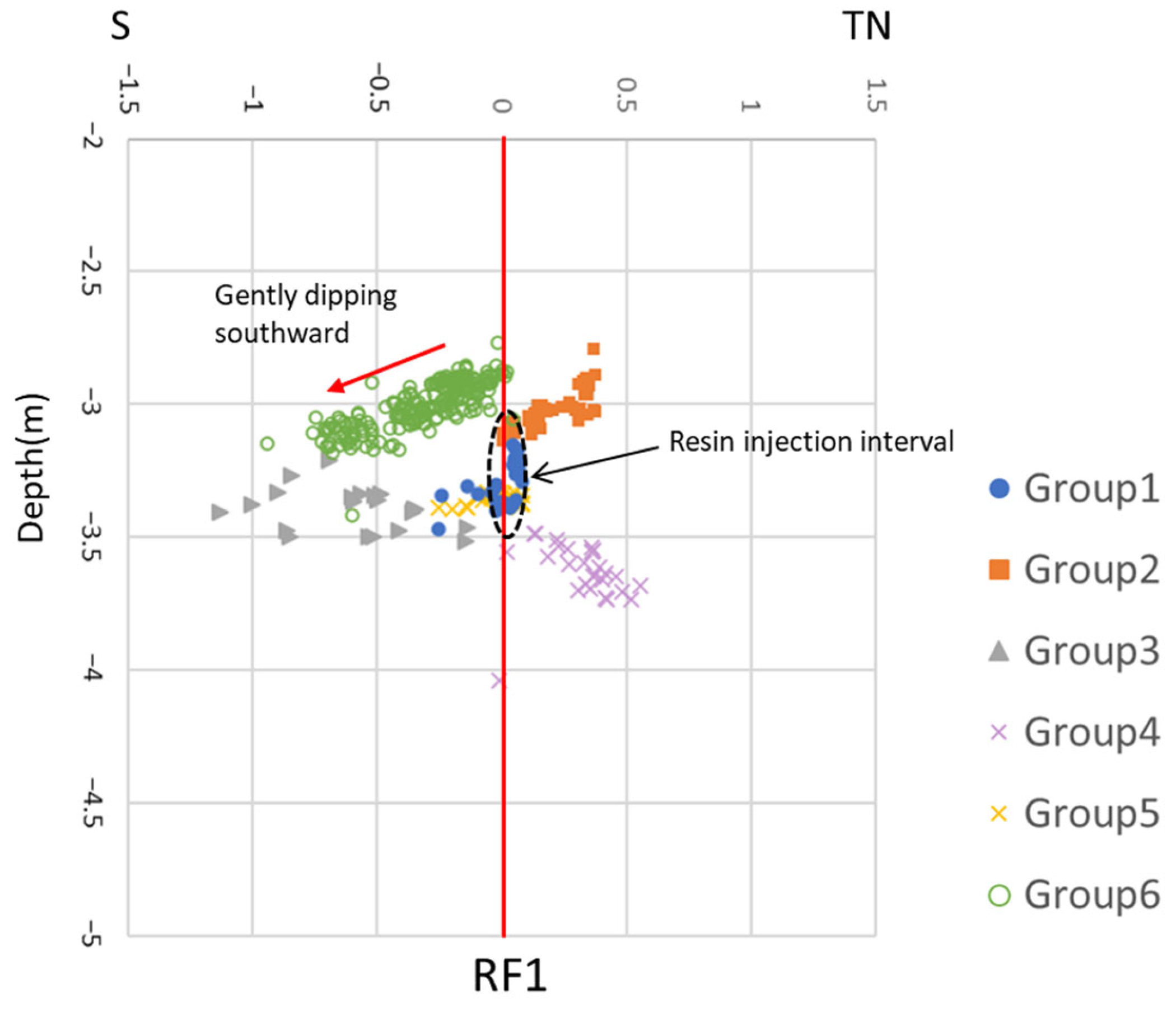
| Item | Condition |
|---|---|
| Sampling rate | 1 MHz |
| Waveform recording | Continuous recording |
| Amplification factor setting | Pre-amplifier gain 40 dB Main-amplifier gain 6 dB Total 46 dB |
| Filter setting |
|
| Well Name | Depth | Breakdown Pressure (Pb) | Reoprning Pressure (Pr), Shut-in Pressure (Ps) | Horizontal Principal Stress | Direction of SH | |||||
|---|---|---|---|---|---|---|---|---|---|---|
| Flow Rate | Pb | Timing | Flow Rate | Pr | Ps | SH | Sh | |||
| - | (m) | (mL/min) | (MPa) | - | (mL/min) | (MPa) | (MPa) | (MPa) | (MPa) | (°) |
| HF1′ | 3.55 | 50 | 9.9 | Breakdown | 50 | - | 5.46 | 11.2 | 5.5 | N58E |
| Reopening #1 | 50 | 2.59 | 5.46 | |||||||
| Reopening #2 | 100 → 300 | - | 4.87 | |||||||
| Reopening #3 | 300 | 4.12 | 4.89 | |||||||
| Average | - | 2.59 | 5.46 | |||||||
| 5.55 | 50 | 12.2 | Breakdown | 50 | - | 9.68 | 22.1 | 8.8 | N72E | |
| Reopening #1 | 20 | 2.22 | 8.84 | |||||||
| Reopening #2 | 50 | 2.18 | 8.82 | |||||||
| Average | - | 2.20 | 8.83 | |||||||
| AE3 | 8.75 | 100 | 15.8 | Breakdown | 100 | - | - | 20.7 | 9.6 | N47W |
| Reopening #1 | 20 | 3.90 | 9.64 | |||||||
| Reopening #2 | 20 | 4.30 | 9.61 | |||||||
| Average | - | 4.10 | 9.63 | |||||||
| 9.80 | 50 | 14.2 | Breakdown | 50 | - | - | 21.9 | 10.2 | N86E | |
| Reopening #1 | 20 → 50 | 4.39 | 10.39 | |||||||
| Reopening #2 | 20 | 4.44 | 10.10 | |||||||
| Average | - | 4.42 | 10.25 | |||||||
| : Not referred for stress estimation | ||||||||||
| Indicator | The second derivative value (DD value) of the Akaike information criterion (AIC) and the number of sensors that meet the criteria. |
| Extraction criteria | More than 8 ch of sensors meet the requirement that DD value ≥ 2.0, and the sensors are distributed in four or more holes. |
Disclaimer/Publisher’s Note: The statements, opinions and data contained in all publications are solely those of the individual author(s) and contributor(s) and not of MDPI and/or the editor(s). MDPI and/or the editor(s) disclaim responsibility for any injury to people or property resulting from any ideas, methods, instructions or products referred to in the content. |
© 2025 by the authors. Licensee MDPI, Basel, Switzerland. This article is an open access article distributed under the terms and conditions of the Creative Commons Attribution (CC BY) license (https://creativecommons.org/licenses/by/4.0/).
Share and Cite
Takeuchi, T.; Fujimoto, A.; Inoue, R.; Ishida, T.; Danjo, T.; Yokoyama, T.; Fujii, H. Outcrop-Scale Hydraulic Fracturing Experiments with a Coagulable Resin and Data Analysis Results. Geosciences 2025, 15, 103. https://doi.org/10.3390/geosciences15030103
Takeuchi T, Fujimoto A, Inoue R, Ishida T, Danjo T, Yokoyama T, Fujii H. Outcrop-Scale Hydraulic Fracturing Experiments with a Coagulable Resin and Data Analysis Results. Geosciences. 2025; 15(3):103. https://doi.org/10.3390/geosciences15030103
Chicago/Turabian StyleTakeuchi, Tsutau, Akira Fujimoto, Ryohei Inoue, Tsuyoshi Ishida, Takashi Danjo, Tatsuya Yokoyama, and Hirokazu Fujii. 2025. "Outcrop-Scale Hydraulic Fracturing Experiments with a Coagulable Resin and Data Analysis Results" Geosciences 15, no. 3: 103. https://doi.org/10.3390/geosciences15030103
APA StyleTakeuchi, T., Fujimoto, A., Inoue, R., Ishida, T., Danjo, T., Yokoyama, T., & Fujii, H. (2025). Outcrop-Scale Hydraulic Fracturing Experiments with a Coagulable Resin and Data Analysis Results. Geosciences, 15(3), 103. https://doi.org/10.3390/geosciences15030103






